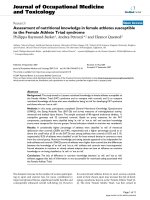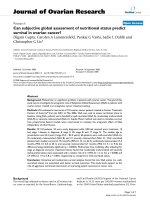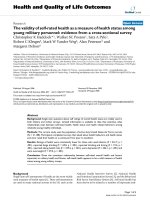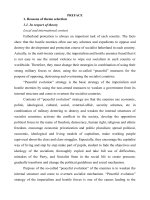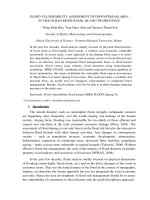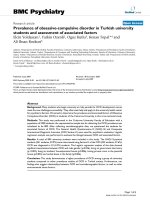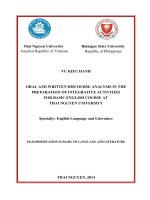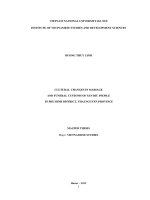Assessment of nutritional status among ethnic minority university students thai nguyen province vietnam
Bạn đang xem bản rút gọn của tài liệu. Xem và tải ngay bản đầy đủ của tài liệu tại đây (1.5 MB, 104 trang )
ASSESSMENT OF NUTRITIONAL STATUS AMONG
ETHNIC MINORITY UNIVERSITY STUDENTS,
THAI NGUYEN PROVINCE, VIET NAM
MRS TRAN THI HUYEN TRANG
A THESIS FOR THE DEGREE OF MASTER OF PUBLIC HEALTH
KHON KAEN UNIVERSITY
2018
ASSESSMENT OF NUTRITIONAL STATUS AMONG
ETHNIC MINORITY UNIVERSITY STUDENTS,
THAI NGUYEN PROVINCE, VIET NAM
MRS TRAN THI HUYEN TRANG
A THESIS SUBMITTED IN PARTIAL FULFILLMENT OF THE REQUIREMENTS
FOR THE DEGREE OF MASTER OF PUBLIC HEALTH
IN NUTRITION FOR HEALTH
GRADUATE SCHOOL KHON KAEN UNIVERSITY
2018
THESIS APPROVAL
KHON KAEN UNIVERSITY
FOR
MASTER OF PUBLIC HEALTH
IN NUTRITION FOR HEALTH
Thesis title:
Assessment of nutritional status among ethnic minority university
students, Thai Nguyen province, Vietnam
Author:
Mrs. Tran Thi Huyen Trang
Thesis Examination Committee:
Prof. Dr. Sastri Saowakontha
Chairperson
Assist. Prof. Dr. Pattara Sanchaisuriya
Member
Assist. Prof. Dr. Suwalee Lowirakorn
Member
Assoc. Prof. Dr. Pongdech Sarakarn
Member
Thesis Advisor:
Assist. Prof. Dr. Pattara Sanchaisuriya
Copyright of Khon Kaen University
i
Tran Thi Huyen Trang. 2561.
การประเมินภาวะโภชนาการของนักศึกษาชาติพน
ั ธุ์มหาวิทยาลัยใ
นจังหวัดไทยเหงียนประเทศเวียดนาม.
วิทยานิพนธ์ปริญญาสาธารณสุขศาสตรมหาบัณฑิต
สาขาวิชาโภชนศาสตร์เพือ
่ สุขภาพ บัณฑิตวิทยาลัย
มหาวิทยาลัยขอนแก่น.
อาจารย์ทป
ี่ รึกษา: ผูช
้ ว่ ยศาสตราจารย์ ดร. ภัทระ แสนไชยสุรยิ า
บทคัดย่อ
ภาวะทุพโภชนาการเป็ นปัญหาสุขภาพทีส
่ าคัญในประเทศกาลังพั
ฒนา นอกจากนี้ ยัง เป็ นปั ญ หาสุ ข ภาพที่ รุ น แรงของกลุ่ ม ชาติ พ ัน ธุ์
การวิจ ยั ครั้งนี้ ด าเนิ น การในกลุ่ม นัก ศึก ษาที่เป็ นชนกลุ่ม น้ อ ยจ านวน
351 ค
น
อ
า ยุ
17 ถึ
ง
29 ปี
ที่ ม ห า วิ ท ย า ลั ย เภ สั ช ศ า ส ต ร์ แ ล ะ แ พ ท ย์ ศ า ส ต ร์ ไ ท ย เห งี ย น
เก็บรวบรวมข้อมูลโดยการสัมภาษณ์ นกั ศึกษาตามแบบสอบถามกึง่ โครง
สร้ า งที่ อ อ ก แ บ บ ไว้ ล่ ว งห น้ าป ระก อ บ ด้ ว ย ข้ อ มู ลลัก ษ ณ ะบุ ค ค ล
ข้ อ มู ล โ ภ ช น า ก า ร ข้ อ มู ล ก า ร วั ด สั ด ส่ ว น ร่ า ง ก า ย
และปั จ จัย ที่ มี ผ ลต่ อ สถ าน ะท างโภชน าการ ผลการศึ ก ษ า พ บ ว่ า
ความชุ ก ของนัก เรีย นที่มี น้ าหนัก ต่ากว่าเกณฑ์ อ ยู่ในระดับ สู ง (ร้อ ยละ
25.4) แต่น้าหนักเกินและอ้วนมีคอ
่ นข้างน้อย (ร้อยละ 4.3 และร้อยละ
0.5, ตามลาดับ ) เพศหญิงมีภาวะน้าหนักต่ากว่าเกณฑ์สู งกว่าเพศชาย
(Adjusted
OR
=
3.2,
95%
CI:
1.55-6.80)
ด้ า น พ ฤ ติ ก ร ร ม สุ ข ภ า พ
พ บ ว่ า
ม า ก ก ว่ า ค รึ่ ง ห นึ่ ง ข อ ง นั ก เ รี ย น ไ ม่ ไ ด้ อ อ ก ก า ลั ง ก า ย
หนึ่ งในสาม ของนั ก ศึ ก ษ ากลุ่ ม ตัว อย่ า งดื่ ม เครื่ อ งดื่ ม แอลกอฮอล์
ส่ ว น อั ต ร า ก า ร สู บ บุ ห รี่ ต่ า (ร้ อ ย ล ะ 4) เ กื อ บ ร้ อ ย ล ะ 40
ข อ ง ผู้ ต อ บ แ บ บ ส อ บ ถ า ม รั บ ป ร ะ ท า น เพี ย ง ส อ ง มื้ อ ต่ อ วั น
การบริโภคพลังงานและปริมาณธาตุอาหารทีม
่ ีธาตุอาหารเสริมบางอย่าง
ไ ม่ เป็ น ไ ป ต า ม ข้ อ ก า ห น ด ร า ย วั น ที่ แ น ะ น า ข อ ง เวี ย ด น า ม
โดยเฉพาะอย่า งยิ่ง วิต ามิ น เอ วิต ามิ น บี 12 โฟเลต เหล็ ก แคลเซี ย ม
แ
ล
ะ
เ
ส้
น
ใ
ย
การวิ เ คราะห์ ปั จ จัย ที่ มี ค วาม สัม พัน ธ์ ก ับ ภ าวะโภ ชน าการพ บว่ า
เพศหญิงและการประเมินค่าน้าหนักตัวสูงเกินไปเป็ นปัจจัยทีส
่ ม
ั พันธ์กบ
ั
ค ว า ม ชุ ก ข อ ง น้ า ห นั ก ต่ า ก ว่ า เ ก ณ ฑ์ ส รุ ป ไ ด้ ว่ า
ภาวะการมีน้าหนักต่าในกลุม
่ ชาติพน
ั ธุ์ชนกลุม
่ น้อยเป็ นภาวะทีน
่ ่ าตกใจโ
ii
ด
ย
เ ฉ
พ
า
ะ
ผู้
ห
ญิ
ง
จากผลการวิจยั มีขอ
้ เสนอแนะว่าควรให้การศึกษาด้านโภชนาการมากขึ้
นโดยมุง่ เน้นทีแ
่ หล่งสารอาหารทีเ่ หมาะสมและประโยชน์ ของพฤติกรรม
ก า ร กิ น เ พื่ อ สุ ข ภ า พ ร ว ม ถึ ง ก า ร อ อ ก ก า ลั ง ก า ย
้ สุขภาพไม่มีปญ
เพือ
่ ให้ม่น
ั ใจว่าเมือ
่ อายุมากขึน
ั หา
iii
Tran Thi Huyen Trang. 2018. Assessment of nutritional status among ethnic
minority university students, Thai Nguyen province, Vietnam.
Master of Public Health Thesis in Nutrition for Health, Graduate School,
Khon Kaen University.
Thesis Advisor: Asst. Prof. Dr. Pattara Sanchaisuriya
ABSTRACT
Malnutrition has been a critical health problem in developing countries. It is
also becoming a serious health problem among ethnic minority groups. The research
was conducted among 351 ethnic minority students aged 17-29 years old at Thai
Nguyen University of Pharmacy and Medicine. The semi-structured pre-designed
questionnaire was used to directly interview students to gather information about
characteristics of individuals, dietary data, anthropometric data and a number of
factors affecting the nutritional status. The results showed that the prevalence of
underweight students was high (25.4%); in contrast, that of overweight and obesity
were relatively low (4.3% and 0.5%, respectively). Females students were statistically
significant underweight than male students (AOR=3.2, 95%CI: 1.55-6.80). A
questionnaire on life style and nutrition concerns indicated that nearly half of students
did not exercise, more than one-third of students drank alcoholic beverage, and
smoking was low in this population (4%). Nearly 40% of participants only consumed
two meals per day. The energy intake and some micronutrient intake did not meet
two-thirds of the Vietnamese Recommended Daily Allowances, especially vitamin A,
vitamin B2, B12, folate, iron, calcium, and fiber. Females and overestimating the
body weight were factors related to underweight prevalence. In conclusion,
underweight status in ethnic minority students was an alarming condition, particularly
among females. More nutrition education, focusing on selective nutrient sources and
the benefits of healthy eating habit as well as physical activity, should be provided to
ensure good health in their adult life.
iv
ACKNOWLEDGEMENTS
First of all, I would like to express my gratitude to my advisors, Assistant
Professor Dr. Pattara Sanchaisuriya. Thank you for all constructive guidance and
statistical advice in doing this work, and constant support not only for doing this
thesis but also for the whole time I was studying in Khon Kaen. Thank you for
tirelessly supporting my work, without ongoing encouragement, interest, and
enthusiasm, I could not have completed this thesis.
Sincere thanks to the Faculty of Public Health, Khon Kaen University for
granting the scholarship that makes my study here feasible and convenient.
I would also like to give my special thanks to Associated Professor Dr.
Kanokwan Sanchaisuriya, and all the professors and lecturers in the Department of
Nutrition for providing me valuable knowledge and experience during my study.
I would also like to express my extremely grateful to Assistant Professor
Woralap Sangvatanachai, who always supported and helped me with English writing
skills, without your help, it would be very difficult for me to complete this thesis.
Sincere thanks also to Thai friends for helping me during difficult times,
cheering me up and for all supports they provided.
Also great appreciation to my lecturers and my colleagues at the Faculty of
Public Health, Thai Nguyen University of Medicine and Pharmacy for their
suggestions and encouragement throughout my course of study.
Lastly, my deepest love and special thanks to my wonderful family for their
love, endless support, and encouragement during my candidature.
v
TABLE OF CONTENTS
Page
ABSTRACT (in Thai)
i
ABSTRACT (in English)
ii
ACKNOWLEDGEMENTS
iii
TABLE OF CONTENTS
iv
LIST OF TABLES
vi
LIST OF FIGURES
vii
LIST OF ABBREVIATIONS
viii
CHAPTER I INTRODUCTION
1
1.1 Background
1
1.2 Research question
3
1.3 Objectives
3
1.4 Hypothesis
4
1.5 Significance
4
1.6 Definition of terms
4
CHAPTER II LITERATURE REVIEW
5
2.1 Overview of nutritional status in the world
5
2.2 Overview of nutritional status in Vietnam
10
2.3 Overview of ethnic groups in Vietnam
13
2.4 Nutritional status assessment tools
17
2.5 Factors effecting nutritional status among university students
22
2.6 Conceptual Framework
30
CHAPTER III RESEARCH METHODOLOGY
32
3.1 Study design
32
3.2 Study population
32
3.3 Sample size and sampling technique
32
3.4 Data collection
33
3.5 Data analysis
36
vi
TABLE OF CONTENTS (Cont.)
Page
3.6 Ethical considerations
CHAPTER IV RESULTS
36
37
4.1 Sample characteristics
37
4.2 Eating habits, self-perceived weight status, and physical activity
37
4.3 Nutritional status
38
4.4 Food consumption patterns
38
4.5 Dietary intake
39
4.6 Factors associated with nutritional status
40
CHAPTER V DISCUSSIONS
60
5.1 Nutritional status and related factors
60
5.2 Dietary intake patterns
66
5.3 Limitation of the study
70
CHAPTER VI CONCLUSIONS AND RECOMMENDATIONS
71
REFERENCES
72
APPENDICES
81
vii
LIST OF TABLES
Page
Table 1
Summary of studies about nutritional status among
8
university students
Table 2
Classification of nutritional status in adults according to BMI
18
kg/m2
Table 3
Summary of studies about prevalence and socio-economic
25
factors of nutritional status
Table 4
General characteristics of study population
41
Table 5
Eating habits among ethnic minority students
42
Table 6
Self-perceived weight status among ethnic minority students
44
Table 7
Doing exercise among ethnic minority students
45
Table 8
Anthropometric data of ethnic minority students according to
45
gender
Table 9
Nutritional status and abdominal obesity index according to
46
gender
Table 10
Frequency of food consumption
47
Table 11
Average nutrients intake and percentage of Vietnamese
49
Recommended Dietary Allowances among students by
gender
Table 12
Association of socio-demographic variables with nutritional
54
status
Table 13
Multinomial logistic regression analysis of factors associated
with nutritional status
57
viii
LISTS OF FIGURES
Page
Figure 1
Underweight percentage among children under five-year-old
11
by years
Figure 2
Stunting prevalence among children under five-year-old by
12
eco-regions in Vietnam
Figure 3
Percentage of underweight in ethnic minorities children
15
under five years old
Figure 4
Percentage of CED in Vietnamese adults by ethnicity
16
Figure 5
Percentage of overweight in Vietnamese adults by ethnicity
17
Figure 6
Conceptual Framework
31
Figure 7
Distribution of macronutrient intake according to the total
53
energy intake
ix
LIST OF ABBREVIATIONS
24 HRs
24 hours dietary recall
BMI
Body mass index
CED
Chronic energy deficient
CI
Confident Interval
FAO
Food and Agriculture Organization
FFQ
Food frequent questionnaire
Kcals
Kilocalories
MDG
Millennium Development Goals
MSG
Monosodium glutamate
NIH
National Institutes of Health
OR
Odd ratio
RDA
Recommended dietary allowance
TUMP
Thai Nguyen University of Medicine and Pharmacy
WHO
World Health Organization
1
CHAPTER I
INTRODUCTION
1.1 Background
Nutritional status is a principal determinant of health. Assessment of nutritional
status, dietary intake, and related factors are worldwide paid attention. Although
recent studies reported that nutritional status has improved remarkably in past
decades, the rates of underweight and overweight remain high and affect human
health, particularly in developing countries [1-4].
Vietnam is a low-to-middle-income country, with 54 ethnic groups of
inhabitants, of which Kinh ethnic group accounts for the majority and fifty-three are
ethnic minorities accounting for 14% of the nationwide population. Most of the ethnic
minorities reside in mountainous areas, covering three-fourths of the country’s
territory. Each ethnic group has its own cultural identity; and the cultural and
consumption behaviors, health culture, and beliefs may positively or negatively affect
the healthcare, health of mothers and children in particular [5-7].
Up to now, nutritional status is a major public health issue that deserves
attention in Vietnam. The proportion of underweight is still high while the percentage
of overweight and obesity demonstrates a sharply growing trend. This makes Vietnam
facing a double burden of malnutrition. The situation leads to the changing of patterns
of morbidity and mortality [8-10].
Studies in a variety of groups about nutritional status in Vietnam have indicated
that the high underweight rate abides. Furthermore, malnutrition is distributed
unevenly; northern and mountain areas have the higher level of malnutrition than the
other regions. Prevalence of malnutrition in rural communities is greater than urban
areas, and malnutrition percentage of ethnic minorities is higher than ethnic majority
group [10, 11]. The National Nutrition Survey 2010 showed that malnutrition rate of
children was highest in the mountains, i.e., 35.2% in central highlands, 33.7% in
northern midland and mountain areas, 31.4% in the north central area and central
coastal zone [11]. A recent study conducted among adults in a northern mountain
2
likewise assumed that the high percentage of the chronic energy deficient (CED) was
31.7% [12]. Another research study in the south of Vietnam also contributed a similar
prevalence of 35% [13]. Simultaneously, the proportion of overweight and obesity has
dramatically increased in both children and adults. The rate of overweight for children
under 5-year-old and adolescents were 5.6% and 17.8%, respectively [11, 14].
Between 2002 and 2015, the percentage of overweight and obesity increased among
adults, ranging from 5.2 % to 15.6% [10, 11, 13, 15-17].
In general, overweight/obesity and underweight severely affect the health and
quality of human life, increase the risk of developing infections, reduce the ability to
work, prolong hospitalization, and augment the risk of illness and death. Thus,
creating an ideal body weight or the “should be” weight is something everyone should
observe. Nevertheless, changes in lifestyle (ex. eating habits, sedentary lifestyle,
physical inactivity, etc.) are keeping pace with economic growth and social [18].
Besides, due to the growing emphasis on convenience, the consumption of ready-toeat foods and fast foods tends to replace traditional meals and becomes increasingly
popular, especially in young people [19].
Undergraduates, as adult people, are valuable intellectual human resources in
the future, especially in a developing country. When students start entering university
doors, a lot of changes will occur in their life, including academic environment,
relationships and eating habits [20, 21]. From the family environment, students will
switch to an independent living environment. They depend on self-regulation when
facing problems of expenditure and need to take care of themselves. For the young
generation, results of living arrangement undesirably alter their food consumption
patterns in terms of variety, nutrient composition and timing of food intake. Based on
substantial evidence that look at the eating patterns in young population, especially
university students, the food consumption patterns and nutrients intake appear to be
undesirable, namely they tend to skip meals frequently [22-25], eat limited food
variety [26, 27], habitually take unhealthy foods [26, 28] and adopt unhealthy eating
practices [29, 30], etc. If they fail to control these problems, the nutritional status, and
their health will be significantly affected, together with diminished ability to acquire
innovative ideas [31, 32].
3
However, to date, limited studies have determined nutritional status among
university students in Vietnam, especially medical students who have to spend a lot of
time to study in the amphitheater and practice long hours including nights and
weekends in hospitals and communities; so their eating habit may not be sufficiently
healthy.
Thai Nguyen University of Medicine and Pharmacy (TUMP) is in the Northeast
of Vietnam and plays a key role in producing medical doctors for the mountainous
provinces of Vietnam. TUMP has approximate five thousand students, of which more
than a third are ethnic minority students. They come from different areas of the
northeastern region where many studies showed that the rate of malnutrition is still
high [33-35]. Moreover, no study conducted about the nutritional status of medical
students as well as separate groups of an ethnic minority in Vietnam. Hence, the better
understanding of nutritional status among ethnic minority students and identifying the
association between food consumption patterns and nutritional status are required.
This study is believed to be the first survey in nutritional status of ethnic minority
students in the northern mountainous area in Vietnam. The results would provide
basic knowledge of nutritional status among this group as well as young adults. This
evidence would contribute to the development of the strategy to prevent nutrition
problems.
1.2 Research questions
What is nutritional status among ethnic minority students at Thai Nguyen
University of Medicine and Pharmacy, Vietnam?
1.3 Objectives
1.3.1 General Objective
To assess nutritional status among ethnic minority students at Thai
Nguyen University of Medicine and Pharmacy, Vietnam
1.3.2 Specific Objectives
To determine the prevalence of malnutrition among ethnic minority
students at Thai Nguyen University of Medicine and Pharmacy,
Vietnam
4
To describe the eating habit among ethnic minority students at Thai
Nguyen University of Medicine and Pharmacy, Vietnam.
To investigate factors associated with nutritional status among ethnic
minority students at Thai Nguyen University of Medicine and
Pharmacy, Vietnam.
1.4 Hypothesis
The problems encountered in terms of individuals, food habits and healthy
behavior affects nutritional status of the ethnic minority university students.
1.5 Significance
This study provides scientific data on the nutritional status and health in young
adults of working age, as well as factors related to nutritional status. The result can
help in laying policies and planning measures for specific nutritional care to improve
nutritional status via the implementing framework of the national strategy on nutrition
and development strategy of human resources.
1.6 Definition of terms
Malnutrition
Malnutrition is a general term indicating an excess, deficit, or
imbalance in one or more of the essential nutrients. Malnutrition
is frequently classified as either underweight or overweight
individual, indicating either inadequate or excessive caloric
intake [36].
Eating habits
Eating habits are defined as what and how people eat, their
selection of food.
Nutritional status
Nutritional status of each individual is the result of supply,
absorption of nutrients from diet and nutrients used in the body.
Nutritional status is classified as either underweight, normal
weight, overweight or obesity based on the body mass index.
Health status
The level of health (good or poor) of the individual, group, or
population as subjectively assessed by the individual or by more
objective measures.
5
CHAPTER II
LITERATURE REVIEW
This study aims to investigate nutritional status among ethnic minority students
at Thai Nguyen University of Medicine and Pharmacy, Vietnam. Literature related to
these subjects was reviewed. This chapter is separated into six parts to review: 1)
overview of nutritional status in the world, 2) overview of nutritional status in
Vietnam, 3) overview of ethnic groups in Vietnam, 4) nutritional status assessment
tools, 5) factors affecting nutritional status, and 6) conceptual framework.
2.1.
Overview of nutritional status in the world
Nutritional status of each individual is the result of supply, absorption of
nutrients from diet and nutrients used in the body. Quantity and type of foods needed
to meet nutrient requirements vary for each person, depending on age, sex,
physiological status, level of physical activities and mental health. A good nutritional
status reflects the balance of energy and nutrients from the dietary intake and energy
expenditure to the need to use the body’s nutrients. Energy balance results when the
number of kilocalories (kcals) consumed equals the number used for energy. The
body weight is an index of this relationship of intake to output. Thus, an imbalance
(deficiency or redundancy) between energy intake and energy expenditure will lead to
underweight (or CED) or overweight and obesity [36].
In the last decade, as a result of economic growth, urbanization and
globalization, the change of global nutrition landscape have, without doubt, impacted
on the eating habits and the health of many societies around the world.
According to the WHO, today a variety of countries face a double burden of
malnutrition, especially in developing countries. There were nearly a half million
adults people all over the world considered to be underweight, at the same time, more
than 1.9 billion people were overweight, and approximately 600 million were obesity
in 2015. Both underweight and overweight has significant threats to human health
[37].
6
Health is factor that directly affects learning ability, creativity, evolution and
future of people life, in particular the young population. Undergraduate students, ages
are in the third decade of life. It is considered as future generations, not only
contributes to the development of economy, society of nations but also the most
crucial role for education about positive healthy lifestyles and health guarantee.
Malnutrition in young people may increase the health risk in adulthood. This is a real
potential threat in the future.
Around the world, there is substantial evidence of problems about the
nutritional status of university students, and some examples are presented in Table 1.
As is illustrated by the Table 1, studies reveal nearly a quarter of underweight
students or overweight students of the whole university students. Generally, the rate
of being underweight in Asian students tends to be higher when compared with
students in other European and American countries. Supa Pengpid (2015) assessed the
nutritional status of 860 Thai students in the age range of 18 to 25, the results of
which indicated that there was a high rate of chronic energy deficiency (21.5%),
overweight and obese (20.8%) [38]. In particular, the rate of chronic energy
deficiency of students from Pakistan was 41.4%, which was significantly higher than
the group of students from Malaysia (27%) and China (27.5%) [39-41].
A cross-sectional study of 557 Canadian undergraduate students reported that
only 8% of samples were underweight, and nearly 27% of the participants were
overweight and 8% were obese. Most of the samples had unhealthy eating patterns.
The majority of overweight students were reported to eat more pork, lamb, veal, fish
and all meats (p < 0.05). Of the remaining students, the percentages of samples
consuming fewer fruits, or vegetables were 33% and 9%, respectively. Just as
important, 14.9% of the respondents reported being on a diet. Almost a quarter of
students reported smoking, and more than one-third of samples reported drinking
alcohol [26].
Another cross-sectional study in Greece also contributed a similar prevalence of
overweight and obesity in undergraduate students. Of the male sample’s population,
there was 32.1% overweight, 5.9% obese and only 0.5% underweight. For female
participants, there was 8.4% overweight, 1.5% obese and more than five percent
underweight. The results of this study indicated that students had the habit of
7
unhealthy nutrition such as not regularly consuming vegetable, eating more fast foods
and fried foods, plus less physical activity. Less than half of males and females
consumed fried foods. More than one-third of male students and almost a quarter of
female students reported eating fast foods more than three times per week [42].
A study was conducted among 200 Malaysian students which showed that
20.9% and 10% of female participants were underweight and overweight,
respectively, while 16.7% and 17.8% of male counterparts were underweight and
overweight, respectively. More than half of total students skipped breakfast.
Compared with recommended demand, the majority of the samples did not meet the
requirement for energy as well as calcium and iron (female only) intake. The
consumption of fruit and vegetable was low, only 18% and 42% of students ate fruit
and vegetable daily. 33.3% of male students and 29.1% of female students reported
eating fast foods one to four times per week [25].
8
Table 1 Summary of studies about nutritional status among university students
Authors
(year, country)
SuPa Pengpid et al
(2015, Thailand)
Study design
Sample size
A cross-sectional survey
860 university students
Results
- 21.5% of participants were underweight.
- 20.8% of participants were overweight and 13% obese.
Ref
[38]
- For male participants: 14.2% underweight, 11.5%
Xiaohua Ren et al
(2015, China)
A cross-sectional survey
2617 university students
overweight, and 2.5 obesity
- For female participants: 27.5% underweight, 2.4%
[39]
overweight, 0.3% obesity
Akhtar Amin Memon
et al (2012, Pakistan)
Nurul Huda and et al
(2010, Malaysia)
Ardith Brunt and et al
(2008, Canada)
- 9% of samples were severely underweight.
A cross-sectional survey
435 medical students
(2010, Greece)
[40]
- 7.6% of samples were overweight.
A cross-sectional survey
624 university students
- 27% of all the samples were underweight.
- 12% of all the samples were overweight or more.
[41]
- 8% of the participants were underweight.
A cross-sectional survey
557 university students
- Approximately 27% of the participants were overweight
[26]
and 8% was obese.
- 32.1%, 5.9%, and 0.5% of male participants were
Michael Chourdakis
and et al
- 41.4% of samples were underweight.
A cross-sectional survey
408 medical students
overweight, obese, and underweight, respectively.
- 8.4%, 1.5% and 5.4% of female participants were
overweight, obese, and underweight, respectively
[42]
9
The high rate of underweight and overweight leads to the severe consequences.
Underweight. Underweight affects the health of each individual and the whole
social community. Especially, for working-age adults, improvement of their
nutritional status will contribute to the reduction of health care cost and increases in
labor productivity and thus contribute to social and economic development.
Underweight will leave in the short - and long-term consequences on health, namely:
The link between underweight and ill health are well established. Underweight
is considered one of the leading global reasons for the burden of disease in the world
[3]. As a result of underweight, many children may suffer from health problems, for
instance, increased rate or severity of infectious diseases (measles, malaria,
pneumonia), diarrhea, anemia, especially in early childhood [43-45]. Among women
of reproductive age, nutritional status essential implications for not only women’s
health, including osteoporosis, chronic fatigue, and fertility impairment, but also
negatively influence pregnancy and infant outcomes, including increased risk of
developmental disabilities in infants, low birth weight, and complicated delivery [46].
Overweight/ obesity. As the economy is growing, the more people's lives are
attention, the higher amount of food is supplied. It helps to increase overweight and
obesity rate in children as well as adults.
Overweight and obesity are associated with some diet-related severe chronic
disease such as coronary heart diseases, hypertension, diabetes, gallstones, stroke and
some kinds of cancer [46-49]. Overweight/obesity in childhood may also cause
detrimental effects on adults at the onset of the non-communicable diseases [3].
Weight gain and loss are associated with blood pressure. The study results
showed that every one-kilogram decrease would reduce 1.0-1.2 mmHg in systolic
blood pressure and 0.8 to 1.0 mmHg in diastolic blood pressure [50-52]. Conversely,
hypertension prevalence increased linearly with each unit of BMI increase [53].
Outcomes of the study done by P. Chhabra et al. to determine the association between
nutritional status and blood pressure of medical students in Dehli showed that 13.4%
of samples were underweight and 11.7% of samples were overweight. This study also
found that the prevalence of grade I hypertension in participants was 7.16%, and the
overweight students were more likely to have hypertension than normal weight
students (p < 0.05) [54].
10
Underweight or overweight/ obesity is causing the impact on economics and
society. Direct consequences are the costs for the treatment of diseases and related
diseases. Indirect consequence is the reduction in production capacity due to diseased
original from obesity, underweight such as anemia, hypertension, diabetes. Therefore,
the prevention of underweight, overweight/ obesity, and maintaining the ideal body
weight is essential at any age to keep a healthy health.
2.2.
Overview of nutritional status in Vietnam
Vietnam is going into the second decade of the twenty-first century with many
changes and variations. The rapid industrial development, as well as economic growth
in Vietnam, has improved the living standard and life expectancy. The shift from a
traditional agrarian economy to an industrial one brings about changes in lifestyle and
improves the health status along with the nutrition of the people significantly. In
recent years, numerous studies of the nutritional status and feeding habits of infants,
children, adolescents and elderly in Vietnam have highlighted those mentioned above.
Among children under five years old, the prevalence of underweight has been
generally and remarkably improved. Vietnam has achieved the reduction of
underweight prevalence as compared to the Millennium Development Goals (MDG),
with a national average of 1.5% per year, from 30.1% in 2000 to 22.9% in 2005 and
17.5% in 2010 [11]. Figure 1 presents underweight percentages among children under
five-year-old by years.
11
Figure 1 Underweight percentage among children under five-year-old by years
Source: National Institute of Nutrition, Ministry of Health (2012). Summary
Report General Nutrition Survey 2009-2010. Hanoi:NIN [11]
However, the percentage of underweight still prevails more than overweight.
The result of Vietnamese National Nutrition Survey from 2001 to 2010 exhibited
three times as high the percentage of underweight people as that of overweight
children (with 17.5% and 5.6%, respectively). The rate of child malnutrition remains
at a high level, with regional disparity. Notably, there were twelve in sixty-four
provinces with more than one-third of stunting percentage, mostly in three regions:
Central Highlands, Central Coastal, and Northern Midland and Mountain areas [11].
The prevalence of stunting by eco-regions is shown in Figure 2.
12
Figure 2
Stunting prevalence among children under five-year-old by eco-
regions in Vietnam.
Source: National Institute of Nutrition, Ministry of Health (2012). Summary
Report General Nutrition Survey 2009-2010. Hanoi: NIN [11].
A study about the nutritional status of adult showed that the prevalence of CED
has declined below 20%; whereas the frequency of overweight and obesity tend to go
up, especially in elder population. The overall percentage of CED reduced from
26.5% in 2000 to 22.1% in 2005 and 17.2% in 2010. However, there was a higher
level of CED in female as compared to male, as well as the higher rate of CED in
rural areas than those in urban regions, particularly in the northern mountain. About
one-third (31.7%) of rural women of reproductive age had CED [12]. Underweight
prevalence increased from 7.4% to 20.5% across urban and rural areas [16]. A
national survey among 3037 Vietnamese adults in 2015 showed that 12.6% of females
and 10.7% of males were underweight, while 14.7% of women and 13.2% of men
were overweight. The highest proportion of underweight was people with age range
from 18 to 29 years old ( 18.4%) and that of overweight was highest among people
over 50 years old (16.7%) [17].
13
In contrast, the overweight and obesity prevalence has been dramatically
increased, more than double in the period from 1992 to 2010 (from 2.0% to 5.6%)
[11, 55]. Substantial increases were found in urban and rural areas. The highest
prevalence of overweight and obesity was people with age range from 55 to 59 years
old (for male was 7.8% and for female 10.9%, respectively) [11]. People in urban
areas tend to be overweight or obese as compared to those in rural communes. The
findings of a study of 1713 participants age ≥ 35 years in the south of Vietnam
indicated that urban residents have a higher percentage of overweight than their urban
counterparts (69% for urban versus 15.5% in rural communes, p<0.05) [16].
A recent survey on the nutritional status of 244 female university students in
capital Vietnam stated that the overall percentage of underweight was extremely high,
or 45.3%. On the other hand, the percentage of overweight was quite low, 1.5% [56].
No study observed nutritional status among separate groups of ethnic minority people.
2.3.
Overview of ethnic groups in Vietnam
Vietnam is a multi-ethnic country with fifty-four distinct groups, of which Kinh
ethnic group accounts for the majority and fifty-three are ethnic minorities, each with
its own language, lifestyle, and cultural heritage. The largest ethnic groups consist of
85.7% Kinh (Viet), 1.9% Tay, 1.8% Thai, 1.5% Muong, 1.5% Khmer, 1.2% Hmong,
1.1% Nung, 1.0% Hoa, 0.9% Dao, 3.4% others (2009 census) [7]. Moreover, 53
different ethnic minority groups inhabiting in Vietnam can divide into eight different
groups according to the Vietnamese language as follows: Muong group with four
ethnicities, Tay-Thai group with 8 ethnicities, Mon-Khmer group with 21 ethnicities,
Mong-Dao group with 3 ethnicities, Kadai group with 4 ethnicities, Malayo Polynesian group with 5 ethnicities, Han group with 3 ethnicities, and Tibeto Burman group with 6 ethnicities [57]. The Kinh people mainly concentrate in the Red
River delta, the central coastal delta, the Mekong delta and major cities. Most of
ethnic minorities reside in the high mountains or extremely remote areas, with
difficult terrain, where public services and basic infrastructure lag behind [7, 58].
Nutritional customs are lifestyle habits in a social life, in production and daily
activities recognized and followed by everyone. Each ethnic group living in different
natural conditions has formed differences in terms of the way to make a living, their

